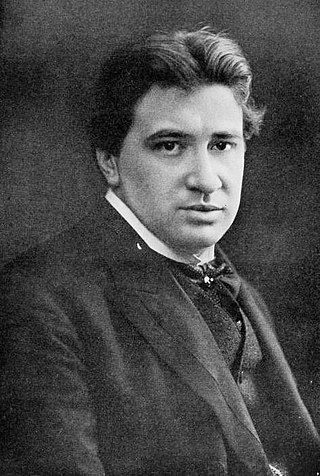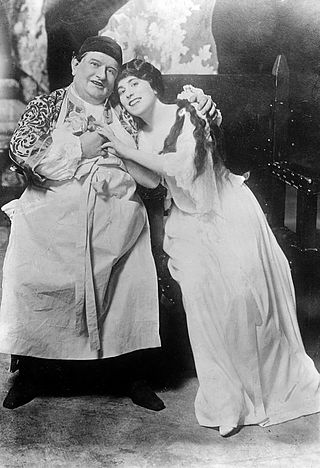Related Research Articles

Le donne curiose is an opera in three acts by Ermanno Wolf-Ferrari to a text by Luigi Sugana after Carlo Goldoni's play of the same name.
La leggenda di Sakùntala is a three-act opera by Franco Alfano, who wrote his own libretto based on Kālidāsa's 5th-century-BC drama Shakuntala. It was completed in 1920. When the score was believed lost in wartime bombing, Alfano reconstructed it, in 1945, now titling it simply Sakùntala, but in 2006 a copy of the original was found.

Siroe, re di Persia, is an opera seria in three acts by George Frideric Handel. It was his 12th opera for the Royal Academy of Music and was written for the sopranos Francesca Cuzzoni and Faustina Bordoni. The opera uses an Italian-language libretto by Nicola Francesco Haym, after Metastasio's Siroe. Like many of Metastasio's libretti, it was also set by Handel's contemporaries, e.g. by Leonardo Vinci, Antonio Vivaldi and Johann Adolph Hasse. Pasquale Errichelli's setting of the libretto premiered in the year of Handel's death.
La fausse esclave is an opéra comique in one act by Christoph Willibald Gluck. Its French-language libretto based on Louis Anseaume and Pierre-Augustin Lefèvre de Marcouville's libretto for La fausse aventurière, an opéra comique by Jean-Louis Laruette. It was first performed on 8 January 1758 at the Burgtheater in Vienna. The full score is lost, but a keyboard version is extant.
Dano Raffanti is an Italian tenor, particularly associated with the Italian baroque and bel canto repertory.

Antigone is an opera in three acts by Arthur Honegger to a French libretto by Jean Cocteau based on the tragedy Antigone by Sophocles. Honegger composed the opera between 1924 and 1927. It premiered on 28 December 1927 at the Théâtre Royal de la Monnaie with sets designed by Pablo Picasso and costumes by Coco Chanel.

Medea is an opera in three acts composed by Giovanni Pacini to a libretto by Benedetto Castiglia. It premiered on 28 November 1843 at the Teatro Carolino in Palermo, conducted by the composer with Geltrude Bortolotti in the title role. The libretto is based on the plays Medea by Euripides and Médée by Pierre Corneille.

Issé is an operatic pastorale héroïque by the French composer André Cardinal Destouches. Initially it was in three acts. The definitive revised version consists of a prologue and five acts. The libretto was by Antoine Houdar de la Motte. Although Destouches was only 25 at the time of its premiere, it is considered his best score.

Semiramide riconosciuta is an Italian opera with serious action, or dramma per musica, by Nicola Porpora, set to a libretto by Metastasio with some textual changes, possibly by Domenico Lalli. The opera was written for some of the finest contemporary singers, and includes a technically demanding series of da capo arias.
Caterina Galli was an Italian operatic mezzo-soprano. She first rose to fame in England in the 1740s and early 1750s where she was particularly admired for her performances in the works of George Frideric Handel. She then enjoyed success in her native country in the 1750s and 1760s, before returning to England, where she remained active as a performer up through 1797.
Ezio is an opera eroica or "heroic" opera in 3 acts by Gaetano Latilla. The opera uses an Italian-language libretto by Pietro Metastasio. Metastasio's libretto was partly inspired by Jean Racine's play Britannicus and had earlier been set to music by George Frideric Handel in 1732. The work's protagonist is the fifth-century AD Roman general Flavius Aetius, returned from his victory over Attila. Latilla's version premiered at the Teatro di San Carlo in Naples on 10 July 1758. The composer both directed and conducted the production and Vincenzo Re designed the sets used in the premiere. The cast included Giovanni Carestini in the title role, Caterina Gabrielli as Fulvia, Maddalena Galli as Onoria, Caterina Galli as Valentiniano III, Gregorio Babbi as Massimo, and Antonio Ambrogi as Varo.

L'amore medico is an opera in two acts by composer Ermanno Wolf-Ferrari. Based on Molière's comedy L'Amour médecin, the work uses an Italian language libretto by Enrico Golisciani. It premiered in a German version by Richard Batka on 4 December 1913 at the Hoftheater in Dresden under the title Der Liebhaber als Arzt.
Der Roland von Berlin is an opera in four acts by composer Ruggero Leoncavallo. The work uses a German-language libretto by Leoncavallo which is based on Willibald Alexis's 1840 historical novel of the same name. The opera premiered at the Königliches Opernhaus in Berlin on 13 December 1904. Its premiere in Italy was given at the Teatro di San Carlo in Naples the following month where it was sung in Italian with the title Rolando.

Siroe, or Siroe re di Persia, is an opera seria in three acts by Johann Adolph Hasse. The libretto was by Metastasio. As with many of the latter's libretti, Siroe was also set by Hasse's contemporaries, for example Vinci, Vivaldi and Handel.
Fedra is an opera in two acts composed by Simon Mayr to an Italian-language libretto by Luigi Romanelli based on Racine's play Phèdre.
Il trionfo di Clelia, Wq. 31, is an opera composed by Christoph Willibald Gluck. It takes the form of a dramma per musica in three acts. The Italian-language libretto by Pietro Metastasio is based on several semi-legendary narratives concerning the founding of the Roman Republic. The opera premiered on 14 May 1763 at the Teatro Comunale di Bologna. Although rarely performed since then, it was revived in London in 2012 at the Royal Opera House's Linbury Studio.
Giuseppe Ferdinando Brivio was an Italian composer, conductor, violinist, and singing teacher who is chiefly known for his operas. His work displays a natural expression and uses figurations similar to that of Antonio Vivaldi.

Maria Carbone was an Italian operatic soprano. She created the lead female roles in two of Gian Francesco Malipiero's operas: the title role in Ecuba and Cleopatra in Antonio e Cleopatra.
Nitocri is an opera in two acts composed by Saverio Mercadante to libretto by Apostolo Zeno adapted by Lodovico Piossasco Feys. The libretto is a fictionalised account of the Egyptian queen Nitocris. The opera premiered at the Teatro Regio in Turin on 26 December 1824.
References
- ↑ Casaglia, Gherardo (2005). "Siroe, 26 December 1758" . L'Almanacco di Gherardo Casaglia (in Italian).